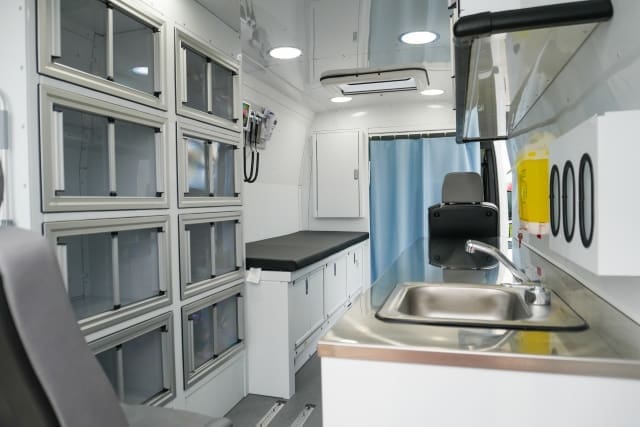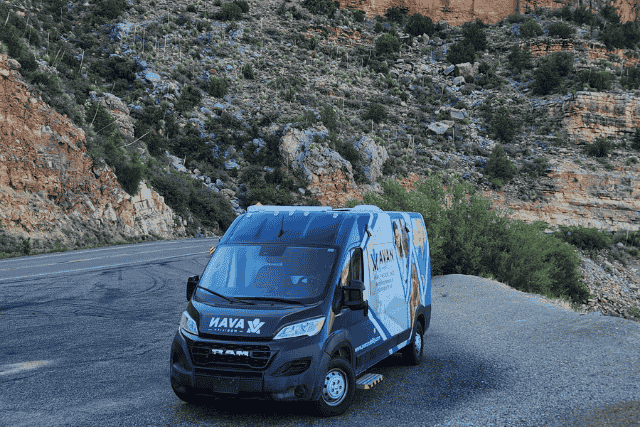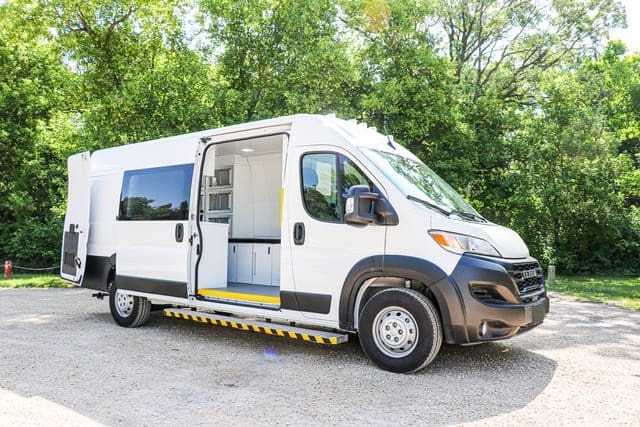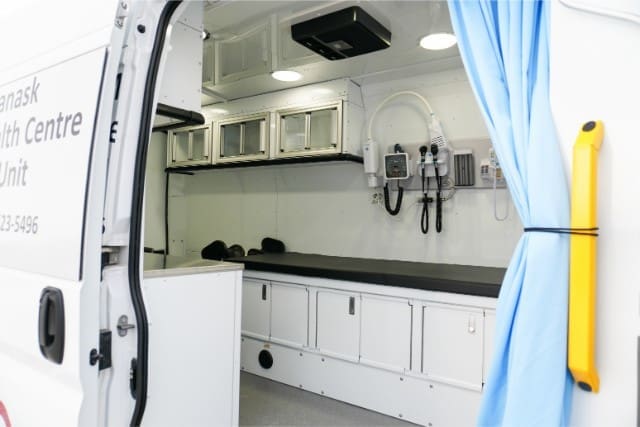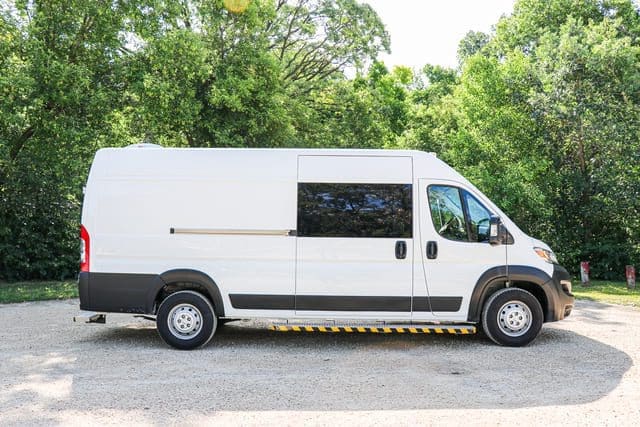Having trouble choosing between a community paramedicine van and an ambulance?
It’s a tough spot to be in. You’re trying to do the right thing, bring healthcare to people where and when they need it, but deciding on the right vehicle to support that goal isn’t simple.
You’ve probably asked yourself things like:
- What’s the real difference between these vehicles?
- Will one serve our community better than the other?
- Are we about to spend money on the wrong solution?
If you feel stuck or unsure, we get it. You’re leading a program meant to close gaps in care, not create new ones. Choosing the wrong setup could leave your team with less flexibility, higher costs, or delays in serving people. But getting it right opens the door to more care delivered in the right place, at the right time, with the right tools.
At AVAN Mobility, we’ve been building vehicles that reduce barriers to healthcare and transportation for over 10 years. We’ve worked with organizations just like yours and the Community Clinic of Southwest Missouri all across the U.S. Our focus is on helping you save lives, not selling you something that doesn’t fit. And we know we’re not the only vehicle manufacturer out there, so we’ll keep this unbiased and helpful.
In this article, you’ll learn the difference between community paramedicine vans vs. ambulances, and by the end, you’ll know which one makes the most sense for your program.
What is community paramedicine?
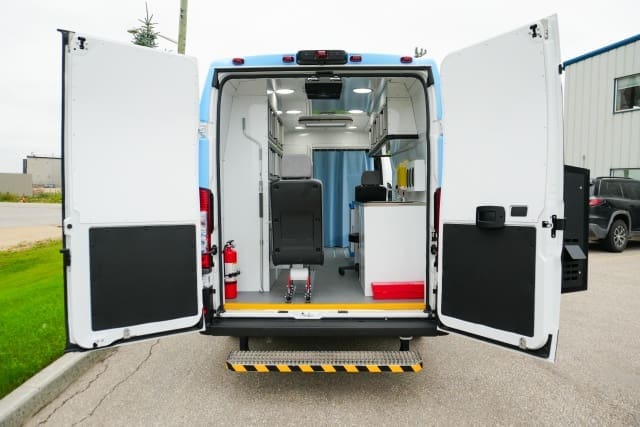
Community paramedicine is a growing healthcare model where paramedics step outside of the usual 911 response and bring care directly into people’s homes or communities before things turn into an emergency.
Think of it like this: Traditional paramedics handle the “oh no!” moments. Community paramedics handle the “hmm, something’s not right” moments before they spiral.
Community paramedicine programs are designed to:
- Help people manage chronic conditions like diabetes or heart disease
- Do follow-up care after hospital discharge
- Reduce unnecessary 911 calls and ER visits
- Connect underserved groups to healthcare services
And it works. In San Francisco, a community paramedicine program for people experiencing homelessness led to a 75% drop in emergency calls and saved the city about $12 million. That’s huge, both for the patients and for the healthcare system.
More and more states are jumping on board. As of 2023, over 40 states in the U.S. have some form of community paramedicine program.
Up next, let’s dig into how community paramedicine vans compare to ambulances, because that’s where things really start to split.
How do community paramedicine vans differ from ambulances?
Let’s start with why these vehicles exist. Both play a role in healthcare, but they’re built with very different goals in mind.
Ambulances are made for emergencies. Period. They’re stocked with life-saving equipment, flashing lights, sirens, and stretchers. The whole design is centered around responding fast, stabilizing patients, and getting them to the hospital quickly.
Community paramedicine vans, on the other hand, are made for prevention. These non-emergency vehicles focus on community health paramedicine services like wellness checks, post-hospital follow-ups, or in-home chronic disease management. Instead of racing toward a crisis, they help people avoid one in the first place.
Here’s a quick breakdown:
| Criteria | Ambulance | Community Paramedicine Van |
| Purpose | Emergency response | Preventative, community-based care |
| Equipment | Life-saving emergency gear | Diagnostic & primary care tools |
| Use case | 911 calls, trauma, transport | Scheduled visits, follow-ups |
So if your program is focused on building trust in communities, improving long-term health, and reducing ER strain, a van for community paramedicine is likely a better match.
Let’s now look at what each vehicle includes when it comes to equipment and space.
Equipment and layout in community paramedicine vans vs. ambulances
You’d never pack for a beach day the same way you’d pack for a mountain hike. The same goes for these vehicles. They’re built out differently for good reason.
Ambulances come with all the bells and whistles for life-or-death moments. We’re talking defibrillators, oxygen tanks, trauma supplies, a stretcher, and very little room to move around once you’re in there. They’re compact, intense, and focused on one thing: fast action in a crisis.
Community health paramedicine vans, on the other hand, are designed to feel more like a basic health clinic on wheels. They often have more space to sit down with patients, take vitals, do basic tests, or even provide telehealth sessions.
Instead of stretchers (though that’s always an option), you’ll find:
- An exam bed
- An office desk
- A sink
- Fridge for vaccines
- Sink
- Floor-to-ceiling cabinetry
- Wi-Fi
- Diagnostic tools
This setup gives providers like yourself more flexibility and comfort, two things that make a big difference during a 45-minute preventive healthcare visit compared to a 10-minute emergency ride.
Next, let’s compare the cost of community paramedicine vans and ambulances because the numbers matter just as much as the features.
Cost comparison: Community paramedicine vans vs. ambulances
Let’s be real, cost plays a huge role when you’re choosing a vehicle for your program. And the price difference between an ambulance and a community paramedicine van can be pretty eye-opening.
Ambulances are built for emergencies, and that kind of equipment doesn’t come cheap. A new ambulance in the U.S. can cost anywhere from $150,000 to $350,000 or more, depending on the type and what’s included.
Community paramedicine vans, meanwhile, are a little more affordable. Most fall somewhere between $170,000 to $290,000, depending on how you customize them. Want a wheelchair lift? An upgraded HVAC system? Telehealth equipment? Those things add cost, but you’re still likely to spend less than you would on a fully loaded ambulance.
Here’s a quick snapshot:
| Vehicle Type | Typical Cost Range |
| Ambulance | $150,000–$300,000+ |
| Community paramedicine van | $170,000 to $290,000 |
Next, we’ll explore the benefits of community paramedicine and how mobile medical vans help expand access to care.
What are the benefits of community paramedicine?
Community paramedicine helps fill important gaps in the U.S. healthcare system. It brings care to people who might not get it otherwise, especially in places where hospitals and clinics are far away or hard to reach.
Over 46 million people live in rural areas in the U.S. Many of these communities face doctor shortages, long travel times, and limited healthcare options. A community paramedicine program gives them another way to stay healthy without relying only on hospitals or 911 calls.
Community health paramedicine supports early care, follow-ups, and check-ins that keep small problems from becoming big ones. This can help reduce pressure on emergency rooms and lower overall healthcare costs.
Here are some of the key benefits of community paramedicine:
Improves access in rural and remote areas: Paramedics bring care to homes, saving people from driving hours to a clinic.
Helps manage long-term health issues: About 6 in 10 adults in the U.S. live with a chronic disease like heart problems or diabetes. These visits help people stay on track with care.
Lowers ER visits and hospital stays: With better follow-up and early care, fewer people end up in the emergency room.
Supports older adults and people with mobility challenges: For those who can’t easily leave home, a home visit can make a big difference.
Builds stronger patient relationships: Seeing the same provider regularly helps build trust and better results over time.
Who should consider a community paramedicine van?
Not every program needs lights and sirens. If your team focuses on preventative care or follow-up visits, a community paramedicine van might be a better fit than a traditional ambulance.
These vans are built for care that happens outside the emergency room. They’re helpful when you want to meet people where they are, especially in areas where getting to a clinic is tough.
A community paramedicine van could be right for you if your team:
- Runs a community health paramedicine program focused on check-ins, home visits, or chronic care
- Works in rural towns, tribal communities, or neighborhoods with limited healthcare options
- Supports older adults, people with disabilities, or others who have a hard time traveling
- Partners with shelters or outreach programs for unhoused individuals
- Wants space for telehealth, mobile labs, or wound care on the go
Programs in states like Minnesota, California, and Texas are already using vans to support community paramedicine programs. For example, the MedStar Mobile Healthcare program in Texas has been nationally recognized for using community paramedics to reduce unnecessary ER visits and help patients manage chronic conditions.
But if your main job is responding to trauma, transporting seriously injured patients, or handling life-threatening emergencies, an ambulance still makes more sense.
It all comes down to the kind of care you’re delivering and how your vehicle can support that care in real life.
Need help to decide if a community paramedicine van vs. ambulance is the right fit?
You came here because you’re trying to make a big decision, one that affects people’s lives, your team’s ability to deliver care, and your budget. Choosing between a community paramedicine van and an ambulance isn’t always clear, especially when both serve different roles.
Here’s what you’ve learned:
- The key differences between vans and ambulances, including cost, equipment, and how each is used
- The real-world benefits of community paramedicine and how it helps reach more people
- What types of programs and communities are a strong fit for a community paramedicine program
At AVAN Mobility, we’ve supported healthcare teams across the U.S. who are just like you: Leaders trying to bring better healthcare to the people who need it most. We’re focused on building long-term solutions designed around your goals.
With over a decade of experience in the industry, we’ve seen how the right vehicle can transform a program and open doors to care that didn’t exist before. Our job is to make sure you’re equipped not just with a van, but with confidence in your decision. If you have questions, click the button below to talk to a mobility expert.
If you’re not ready to talk just yet, we’ve got other helpful resources you can check out to keep learning.
Start by learning how to secure grants for your community paramedicine program.
After that, get a better idea about what you can expect in your Discovery Call with us.
